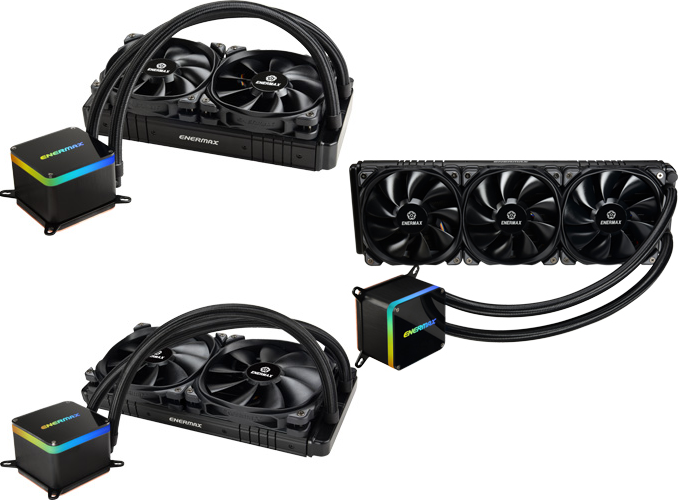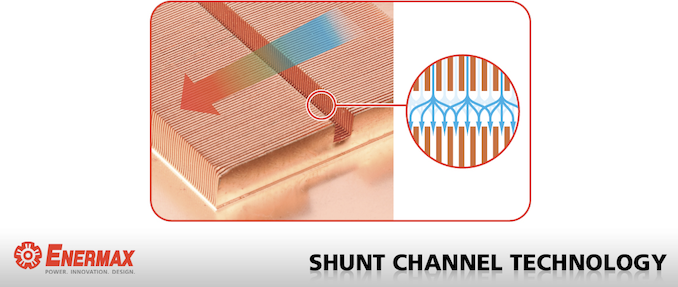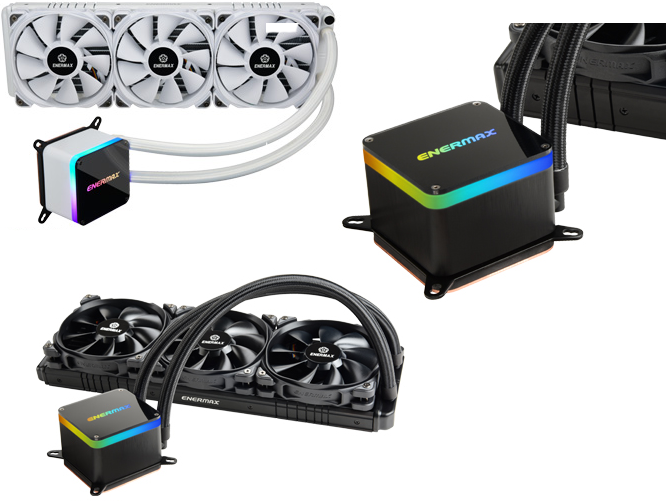Enermax Unveils 500W-Capable LiqTech II LCS for Mainstream CPUs
by Anton Shilov on December 10, 2018 11:00 AM EST- Posted in
- Cases/Cooling/PSUs
- CPUs
- AMD
- Intel
- Enermax
- Liquid Cooling
- LiqTech

Enermax has introduced its new family of all-in-one liquid cooling systems (AIO LCS) for mainstream and high-end desktop CPUs. Capable of dissipating upwards of 500W of heat, the LiqTech II lineup includes models with 240-mm, 280-mm, and 360-mm radiators, all featuring a high-performance pump. To make the devices more attractive to modders, Enermax is also offering one of the LiqTech II SKUs in white.
Interestingly, Enermax seems to be aiming for overkill here. The company, one of a handful of AIO LCS makers to target AMD's Threadripper platform, is porting their TR4 cooler design to this more mainstream cooler.
The Enermax LiqTech II coolers are compatible with all mainstream sockets in use today, as well as Intel's HEDT socket, meaning it works with Intel’s LGA2066/2011/1366/115x sockets as well as AMD’s AMx/FMx. However AMD's TR4 socket continues to require one of the company' specialized extra-large TR4 coolers.
The new AIO LCSes use the EF1 pump featuring a ceramic nano PI bearing, a micro-channel cold plate (complete with a shunt channel), a flow rate of 450 Liters/hour, and addressable RGB lighting that connects to its radiator using weaved polyamide rubber tubing. Depending on exact model, the LiqTech II coolers are equipped with two or three fans featuring a high-pressure blade design as well as anti-vibration rubber pads to reduce noise.
All of Enermax's LiqTech II LCSs are rated for over 500 W of cooling, which is a steep upgrade from the first-gen LiqTech LCS (~300 W), which pre-dated the company's more recent TR4-inspired designs.
| Specifications of Enermax LiqTech II-Series Cooling Systems | |||||||
| LiqTech II 240 ELC-LTTO240-TBP |
LiqTech II 280 ELC-LTTO280-TBP |
LiqTech II 360 Black: ELC-LTTO360-TBP White: ELC-LTTO360-TBP-W |
|||||
| Dimensions | Waterblock Pump |
Length | 71 mm | ||||
| Width | 71 mm | ||||||
| Height | 63 mm | ||||||
| Radiator | Length | 274 mm | 313 mm | 394 mm | |||
| Width | 120 mm | 140 mm | 120,, | ||||
| Depth | 39 mm | 28 mm | 28 mm | ||||
| Fan | Length | 120 mm × 2 | 140 mm × 2 | 120 mm × 3 | |||
| Width | 120 mm × 2 | 140 mm × 2 | 120 mm × 3 | ||||
| Depth | 25 mm | ||||||
| Fan (single) | Speed (RPM) | 500-2300 | 500-1500 | 500-2300 | |||
| Airflow (CFM) |
23.81 ~ 102.17 | 31.86 ~ 80.71 | 23.81 ~ 102.17 | ||||
| Static Pressure (mm-H2O) | 0.673 ~ 6.28 | 0.960 ~ 4.812 | 0.673 ~ 6.28 | ||||
| Noise (dBA) | 14 ~ 28 | 14 ~ 25 | 14 ~ 28 | ||||
| Power | 3.6 W | 2.4 W | 3.6 W | ||||
| MTBF (hrs) | ≧160,000 @ unknown oC | ||||||
| Connector | 4-pin PWM connector | ||||||
| Pump | Speed (RPM) | 3000 (needs to be confirmed) | |||||
| Life Expectancy | ≧100,000 @ unknown oC | ||||||
| Power | 4.8 W | ||||||
| Tubing Length | 400 mm | ||||||
| Compatibility | AMD | AM4/AM3+/AM3/AM2+/AM2/FM2+/FM2/FM1 | |||||
| Intel | LGA 2066/2011-3/2011/1366/1156/1155/1151/1150 | ||||||
| TDP | ≧500 W | ||||||
The motive behind Enermax’s the move to adapt its LiqTech TR4 II to other CPUs is clear: Intel’s ‘extreme’ Core i9-9980XE dissipate 165 W of power at stock clocks and will dissipate far more when overclocked. Besides, Intel’s mainstream Core i7/i9 processors go well above their official sub-100W TDPs provided that they are cooled properly, which means that better cooling translates into higher performance in many cases.
Enermax plans to start sales of its LiqTech II coolers in early December. The company has not announced pricing, but considering the fact that the LiqTech II TR4 LCS starts at $140, it is likely that versions for other CPUs will start at around the same price point.
Related Reading:
- Enermax Launches LiqTech TR4 AIO LCS for AMD's Threadripper: 100% IHS Coverage, 500 W TDP
- Enermax Unveils LiqTech TR4 II LCS: A 500W TDP Threadripper 2 Cooler
- Corsair Unveils Hydro H100i & Hydro H115i RGB Platinum LCSes with Mag Lev Fans
- Cooler Master Launches MasterLiquid ML360R RGB 360-mm AIO Cooler with RGB
Source: Enermax (via Hermitage Akihabara)













12 Comments
View All Comments
PeachNCream - Monday, December 10, 2018 - link
The price puts it firmly into the "Eh, whatever" category of lifestyle accessories alongside gemstone-encrusted high heels and gold-plated cell phones.kupfernigk - Monday, December 10, 2018 - link
It's relatively cheap compared to the CPUs that might benefit. So long as the die temperature is sensible, the more cooling power electronics get, the better.JoeyJoJo123 - Monday, December 10, 2018 - link
This. High performance AIOs have their place in the market. Some people don't want to go full open loop, or even have to worry about loop maintenance, yet they still may want to hit a higher overclock than would be reasonable for a tower cooler.OK, so $140 and up may not be what you're willing to pay for a high performance cooler... Yet, other people would be willing to pay a premium over the average ~$100 AIO to get more headroom and lower temps and more stable overclocks--Mind you without any of the associated open loop maintenance.
Personally, if the prices approach ~$200 levels, then I'd probably prefer to go for the EK aluminum loop kits, like the EK Fluid Gaming A240G or A360G. GPUs being a lot more sensitive to lower temps for boost clocks and being a bigger component towards FPS throughput in games would makes it such that IMO spending anything more than ~$150 on cooling for the CPU but leaving the GPU stock a bit of an oddball choice.
Still, I can see why people would want a high performance AIO just for the hands-free maintenance aspect.
PeachNCream - Tuesday, December 11, 2018 - link
There is a point where diminished returns are reached and it is well below the cost of this particular AIO. Additional cooling might prolong the life of the processor in question, but the owner of said CPU is likely to upgrade long before the CPU fails due to heat-related problems. After all, most processors are rated to operate reliably at close to 100C for the duration of their warranty period. Running said processor at 80C is reasonable and one can reasonably expect functionality for years after the warranty ends until the CPU really isn't powerful enough to do the job (like right now, I'm still running a C2D P8400 and a Sandy Bridge i5-2520m and neither has had especially good cooling given they're shoehorned into laptops yet they're still working properly and the C2D is on 24/7 as a file server).Then there might be the overclocking argument, but in market segments were one of these coolers might appeal (gaming) a MUCH lower end CPU will offer an identical gaming experience because most games have been GPU limited in the last decade or more so a modest processor can offer the same experience. I recently watched a Youtuber fire up a handful of 2018 titles on a Phenom x4 dinosaur (https://www.youtube.com/watch?v=Iktce3Tjl6Q) which proves that point rather plainly. A GPU and RAM upgrade done in a later video further underscores the lack of relevance of the CPU and the need to buy high end or overclock. That takes a lot of wind out of cooling like this.
There is the benefit of quiet operation, but there are very quiet air coolers out there too. Anyway, this thing ultimately lands in the fashion accessory category of computing hardware and arguments supporting it for practical purposes fall short.
PeachNCream - Tuesday, December 11, 2018 - link
Meh, the closing parens on the hyperlink got sucked into the URL. https://www.youtube.com/watch?v=Iktce3Tjl6QMikkelagn - Monday, February 11, 2019 - link
I would definitely go for this AIO when it hits the European market, if ever...Currently using a DeepCool Captain EX 360 and am not satisfied with the cooling performance, as my ML120 Pros have to ramp up waaay too much and I'd like my system to be quieter.
NZXT X72, Corsair H150i Pro and ASUS ROG Ryujin 360 were my previous consideration, however, for the same price, this has a much higher TDP, probably due to the better pump and coldplate, compared to the Asetek BS.
From a silence standpoint, this is unbeatable.
Dragonstongue - Monday, December 10, 2018 - link
cooling potential is likely to "impact" Intel more than AMD at this point seeing as Intel is chasing "get the clocks as high as possible even if TDP goes out the window" which in itself is an absolutely useless measure to be used these days (seeing as many not just Intel blow way past it or cannot actually do what they claim they will) especially with their newest core i 9xxx chips, for AMD "not so much" at least for all but TR/EPYC chips with their tons of cores and threads which shoot out a bunch of heat (especially overclocked) that needs to be displaced.Unfortunately many motherboard makers as of late are not taking into account liquid cooling (like they probably should) are not using the greatest VRM designs which promote focus on RGB crud instead of good heatsink over the VRM they do use, as a result even though the liquid cooler or AIO can "handle" the higher clocks the boards themselves (in most cases) cannot IMO.
In many ways most of these motherboards are way too focused on RGB with some having ability to do liquid via headers but then are plopped into cases that are all glass starved of air. Case makers should take such into account, have ability to use liquid BUT make sure there is room for at least some supplementary bypass fans specifically so that other board components (such as VRM or storage/ram) do not get "cooked" from lack of direct airflow that they require even more so when things run that much faster.
Anyways, I honestly do not see this (or any liquid cooler) lasting 11+ years in all but the very best of circumstances, though if they do, that is wonderful as say $200 CAD is a very "low cost" considering the cooling ability given.
I am not entirely convinced of the noise ratings nor wattage for the unit (4.8 w seems low for a pump does it not?) I know fans wise that actually seems quite high as many of my fans even the high performance ones use 2w or less per fan. Noise wise, they would be far from the first to "claim" such low noise levels and very high CFM but when used in real world fall way short of such claims (look at coolermaster, corsair, thermaltake and others :P).
I also wonder how the fans and pump connect to the motherboard as while pictures might be "pretty" when no wires are attached makes seeing "difficult" to imagine ^.^
Icehawk - Monday, December 10, 2018 - link
I've got an H80 that is over 6 years old, still works the same as new on a 3770.11+ years? That puts you all the way back to Core2Duos man. I don't want a PC that old - finding parts for it are nigh unto impossible, hard enough with something just 4-5 years old.
PeachNCream - Tuesday, December 11, 2018 - link
Lots of C2D hardware can easily be purchased for relatively low cost if you don't mind used components. Ebay is a good source. I bought an Intel E8400 for under $10 with free shipping a couple of months ago to upgrade an old desktop PC.boozed - Monday, December 10, 2018 - link
"Shunt channel"Who approves a patent on cutting a perpendicular slot in a finned heatsink?